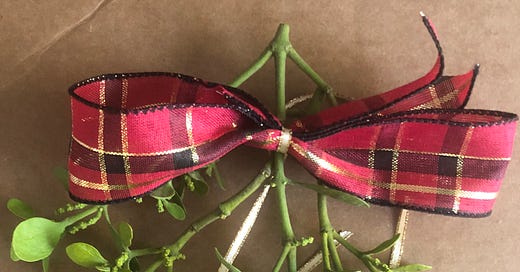HOLIDAY MISTLETOE
Farmer's markets are not only stocked to the brim with fruits and vegetables this time of year but they're catering to shoppers with wreaths and mistletoe, too.
The origins of kissing under the mistletoe are traced back to Norse mythology. A warrior’s mother casts powerful magic to make sure that no plant grown on earth could be used as a weapon against her son. The one plant the spell does not reach is the mistletoe, as it mostly doesn’t grow out of the earth but out of a tree’s branches. Mistletoe, ironically a parasite a plant that often bears white berries, grows in the branches of hawthorn, poplar, lime, and apple trees. One scheming enemy, upon learning this, makes a spear out of mistletoe—the spear that would eventually kill that warrior.
Surprisingly, that tradition of a plant being used as a deadly weapon and later in time to be used in a tender act of kissing under a sprig of mistletoe started in Ancient Greece—first during the festivals and later in marriage ceremonies, due to the plant's then-current association with fertility. Later during the Roman era, enemies at war would reconcile their differences under the mistletoe, which to them represented yet something else— peace.
Kissing under the mistletoe wasn’t a thing until after 1720 because the most extensive research about the plant was published that year. And it did not reference kissing.
Kissing requires no spoken communication but just a passing thought or a longing look accompanied by utmost fondness. European literature and art from the 18th and 19th centuries expanded upon such a kissing theme. Charles Dickens in The Pickwick Papers, published in 1837, portrays the holiday frenzy associated with kissing. He wrote that younger ladies “screamed and struggled, and ran into corners, and threatened and remonstrated, and did everything but leave the room, until some of the less adventurous gentlemen were on the point of desisting, when they all at once found it useless to resist any longer, and submitted to be kissed with a good grace.”
Here the popularity of mistletoe smooching as a Christmas tradition can be traced back to Washington Irving’s The Sketch Book, published in 1820.
And surprise! There are now many kinds of kisses. There’s the Eskimo kiss. An air kiss. The, ahem, excuse me, the famous French kiss. And the ahem, ahem, ahem, the notorious hickey. In addition, there are many many more for the curious who can’t resist a deep dive into Google to learn about them.
A mistletoe-assisted tender kiss on the cheek can be oh-so casual or way-more-serious one on the lips can signify promise and togetherness in all its glory. The act of kissing can be simply sweet or impossibly complicated, but it can surely tell someone you care for them!
![[VINTAGE MORELS] adventures with a home cook](https://substackcdn.com/image/fetch/w_80,h_80,c_fill,f_auto,q_auto:good,fl_progressive:steep,g_auto/https%3A%2F%2Fsubstack-post-media.s3.amazonaws.com%2Fpublic%2Fimages%2Ffa5d998f-e036-4ca5-8421-d2d7bc6558e2_335x335.png)

![[VINTAGE MORELS] adventures with a home cook](https://substackcdn.com/image/fetch/w_36,h_36,c_fill,f_auto,q_auto:good,fl_progressive:steep,g_auto/https%3A%2F%2Fsubstack-post-media.s3.amazonaws.com%2Fpublic%2Fimages%2Ffa5d998f-e036-4ca5-8421-d2d7bc6558e2_335x335.png)

